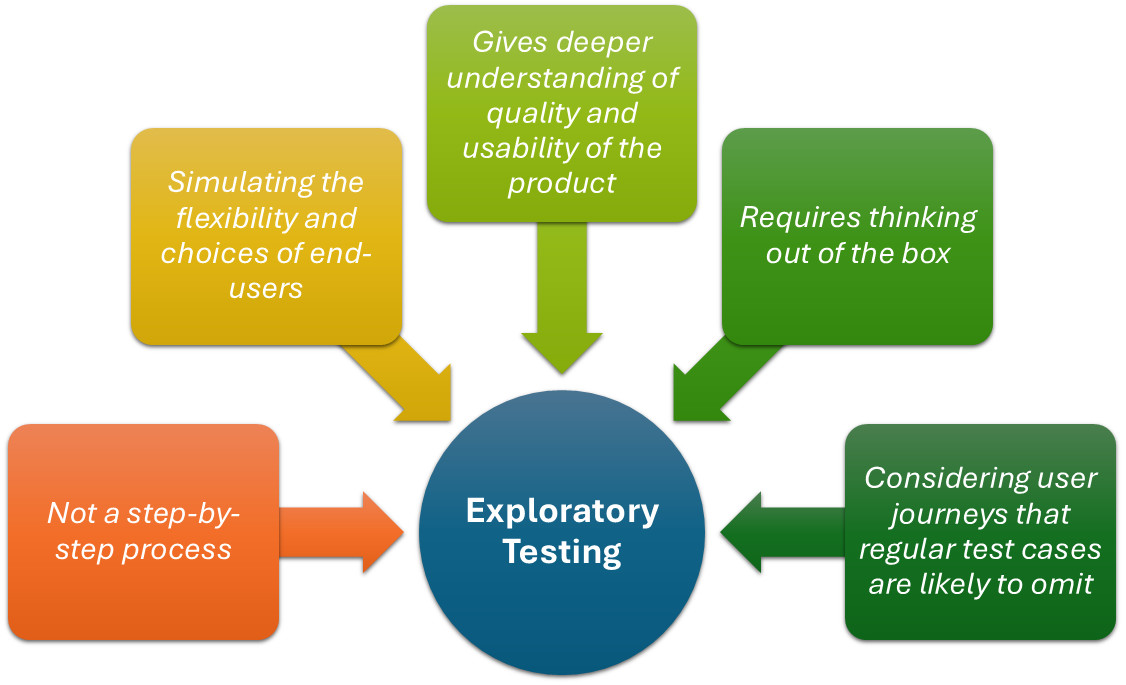Exploratory Testing: How Do You Approach it as a QA Engineer?
|
|
“Exploratory testing is not so much a thing that you do; it’s far more a way that you think.”
Exploring an application, as easy as it may seem, can be a taxing endeavor for the novices. Ask a veteran tester, and they’ll tell you how truly challenging exploratory testing is. It’s not an aimless walk in the park. Rather, it’s a walk where you have a fluid plan to make the most of this exercise. So today, let’s talk about how you can get the most out of exploratory testing.
What is Exploratory Testing?
The exploratory testing process vividly contrasts with other, more structured testing activities. Some teams even neglect it altogether due to exploratory testing not being a “true QA activity”, although we think this cannot be further from the truth. Instead, this type of testing is a very creative activity that allows QA people to identify various software defects that otherwise could’ve been overlooked with a more structured approach.
Here’s an article that explains the differences between structured and exploratory testing well – Exploratory Testing vs. Scripted Testing: Tell Them Apart and Use Both.
Exploratory Testing Definition

First, let’s start with defining what this approach is. The actual test cases that the tester will carry out are not established during exploratory testing. Instead, individuals or groups taking the tests decide what area they will focus on, and what they will do at each point in the test. There is no defined approach that describes the step-by-step process and its desired outcome. That’s why many prefer using test charters for guidance.
The primary goal of this unique testing method is to allow testers to simulate the flexibility and choices of individual end-users. As a result, software testers engage in this process to get a deeper understanding of the quality and usability of the final product. When it comes to testing, it doesn’t need a lot of preparation since testers may choose what features and scenarios they want to focus on.
During this kind of testing, the tester is expected to think outside the box. We can think of exploratory testing as thinking of user journeys that regular test cases are likely to have omitted. The number of possible user inputs in a complex application can be staggeringly large. Sometimes, it is not feasible for testers to cover every possible test case.
As a user, you may have mindlessly explored your favorite game and uncovered glitches when certain combinations of player inputs were entered. Exploratory testing works on similar principles.
Types of Exploratory Testing
Here are three basic types of exploratory testing:
Unplanned/Improvised Exploratory Testing
This form of testing takes a freestyle approach to testing and does not contain any strict rules, methodologies, or requirements. Sometimes, this sub-type of testing is also called ad-hoc. This method works well in scenarios where the tester approaches a new project that they’re not familiar with. It’s one of the fastest ways to get a feel of how the software works and potentially uncover flow imperfections.
User Scenario-based Testing
Real-world situations are the basis for this kind of exploratory testing, in which the software is tested from every aspect to make sure it matches the scenario. This approach can precede the stage where test cases are being written. The primary goal of this form of testing is to examine the software in as many different ways as possible in order to guarantee the comprehensiveness of the test cases.
Strategic Exploratory Testing
This sort of testing is carried out by a skilled tester who is well conversant with the program under test. In order to find more complex issues, this approach uses a variety of testing approaches, such as equivalence, risk-based testing, and error guessing.
How to Approach Exploratory Testing?
Exploratory testing is like going on a journey without a fixed map. As a QA engineer, it means testing software in a more flexible and creative way, rather than following a strict set of instructions. Exploratory testing is really about being creative and curious, letting your intuition guide you to find things that others might miss.
Here’s how you can approach it:
- Understand the Basics First: Before you start testing, make sure you know what the software is supposed to do, who will use it, and the main features.
- Use Your Knowledge and Experience: Think about the possible areas where things could go wrong, based on what you already know about the app. For example, you might explore areas with a lot of user input or places where users interact with the system in unexpected ways.
- Test While Learning: As you interact with the software, pay close attention to anything unusual. If you notice something unexpected or odd, dig deeper into that part of the software.
- Document What You Find: Take notes of anything that doesn’t work right, even if you’re not sure if it’s a bug or just a quirk of the app. You might not have detailed steps at first, but record what happened and where you were in the software.
- Go Back and Try Again: If you discover a bug or something strange, go back to test it more thoroughly and explore other areas that might be related.
- Learn as You Go: The idea is to explore the app while learning about how it works and where things might break. You don’t always follow a script; instead, you go with the flow, staying curious about different parts of the software.
Some Challenges of Exploratory Testing
Exploratory testing, when done correctly, is a lot more complicated than going through existing test cases. Thus, it requires highly skilled testers, and finding and mastering the right talent is both costly and time-consuming.
Another challenge is the wide range of testing. It’s pointless to engage testers who utilize the same methodologies, since the results will be the same. When it comes to testing, diversification is crucial. When every tester on the team is using the same devices and is exploring the same user scenarios, the results will be redundant.
It might be difficult to measure the success of exploratory testing and calculate the return on investment.
Exploratory Testing in Agile
In an Agile environment, you are constantly working in short sprints to deliver small features and improvements. Since the project is always evolving, testers don’t always have detailed, rigid test scripts to follow. With exploratory testing, the software is swiftly evaluated on the fly. Testers are permitted to investigate the product from any angle, using their originality and ingenuity. This kind of testing uncovers defects and edge-case situations that would have otherwise gone unnoticed by other ways of testing. This method of testing enables testers to learn and test the product concurrently, which is critical in an agile setting, allowing for speedy feedback.
Developers and testers are sometimes required to work on additional features or functions as the project advances, as the scope of the requirements expands. Exploratory testing then helps QA to respond to changes swiftly, without having to alter the whole test plan.
How testRigor Helps with Exploratory Testing
One of the drawbacks of exploratory testing is the difficulty of keeping track of all the steps you did to arrive at a specific bug. It is tedious to manually keep track of all the different inputs entered, and reproducing the bug is always challenging.
testRigor, a powerful Gen AI-based test automation tool, can help you with automating exploratory testing in different ways.
- Let Generative AI Explore for You: testRigor offers a generative AI feature that can create a bulk of test cases on your behalf in plain English language. All you need to do is provide a descriptive prompt for the AI engine to work on, along with other details like the URL of the application to test, the platform to test on, and more. Read more about this over here – How to Create Tests in Seconds with testRigor’s Generative AI.
- The Record-and-Playback Way: With testRigor’s Chrome extension, you can record the steps and automatically record the input values at every stage. Most importantly, you now have the playback feature available. This allows you to recreate the same test on a different browser and OS without having to manually redo the steps. Read more about this over here – How to use testRigor’s test recorder for record and playback testing?
testRigor seamlessly integrates with the most common bug tracking and test case management systems (Jira, TestRail, and many others). Your exploratory tests can be tracked, and issues that need to be fixed can be prioritized accordingly. The ticket created in Jira with the help of testRigor will have the steps necessary to reproduce the defect.
Test across platforms, browsers, and operating systems using plain English language. With this tool, you can automate a host of scenarios, including graphs, images, chatbots, LLMs, Flutter apps, mainframes, and many more.
Read more on how testRigor simplifies exploratory testing over here – How to Automate Exploratory Testing with AI in testRigor.
Conclusion
Exploratory testing remains a viable and very valuable type of testing methodology that allows QA teams to uncover bugs of various types while also realizing time savings. It is necessary for testers to have an adequate understanding of the product and user needs and a clear goal in mind. Another key to success is to always log each issue right away; otherwise, you’re risking losing track of it – however, this is the area where an automated test recorder will help.
| Achieve More Than 90% Test Automation | |
| Step by Step Walkthroughs and Help | |
| 14 Day Free Trial, Cancel Anytime |












